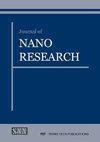Systematic Characterization of the Crystalline Phase Transformation, from Amorphous to Rutile through Anatase, of TiO2 Nanofibers Synthesised by Electrospun Technique
IF 1
4区 材料科学
Q4 MATERIALS SCIENCE, MULTIDISCIPLINARY
引用次数: 0
Abstract
TiO2 nanofibers were synthesised by means of the electrospun technique, which were annealed at high temperatures to achieve the crystalline phase transformation from amorphous to rutile through anatase and the phase mixture. The chemical stoichiometry of electrospun TiO2 nanofibers was estimated by EDS, finding that at low annealing temperatures excess of oxygen was detected and at high temperatures excess of titanium that originates oxygen vacancies. The TEM images showed clearly the formation of TiO2 nanofibers (NF’s) that exhibit a homogeneous and continuous aspect without the presence of crystalline defects, whose surface morphology depends strongly on the annealing temperature. The crystalline phase transformation was studied by Raman spectroscopy, which revealed that annealed TiO2 NF’s showed a crystalline phase transformation from amorphous, pure anatase, anatase-rutile mixed, to pure rutile as the annealing temperature increased, which was corroborated by X-ray diffraction and high-resolution TEM. The average grain size, inside the NF´s, increased with the crystalline phase transformation from 10 to 24 nm for anatase-TiO2 and from 30 to 47 nm for rutile-TiO2, which were estimated by using the Scherrer-Debye equation. By absorbance measurements at room temperature the band gap energy (Eg) was obtained, which is ranged in 3.75-2.42 eV, caused by the amorphous → anatase → anatase-rutile mixed → rutile crystalline phase transformation.电纺丝法合成TiO2纳米纤维由无定形到锐钛矿晶相转变的系统表征
采用静电纺丝法合成了TiO2纳米纤维,并对其进行高温退火,使其通过锐钛矿和相混合物由无定形到金红石的结晶相变。利用能谱仪对静电纺TiO2纳米纤维的化学计量学进行了估计,发现在低退火温度下检测到过量的氧,在高温下检测到过量的钛,导致氧空位。透射电镜(TEM)图像清楚地显示,TiO2纳米纤维(NF 's)的形成具有均匀和连续的特点,没有晶体缺陷,其表面形貌与退火温度密切相关。通过拉曼光谱分析发现,随着退火温度的升高,退火后的TiO2呈现出从无定形、纯锐钛矿、锐钛矿-金红石混合到纯金红石的晶体相变,通过x射线衍射和高分辨率透射电镜证实了这一点。根据Scherrer-Debye方程,随着晶相转变,锐钛矿- tio2的平均晶粒尺寸从10 nm增加到24 nm,金红石型- tio2的平均晶粒尺寸从30 nm增加到47 nm。通过室温吸光度测量,得到了非晶→锐钛矿→锐钛矿-金红石混合→金红石结晶相变引起的带隙能(Eg)在3.75 ~ 2.42 eV之间。
本文章由计算机程序翻译,如有差异,请以英文原文为准。
求助全文
约1分钟内获得全文
求助全文
来源期刊

Journal of Nano Research
工程技术-材料科学:综合
CiteScore
2.40
自引率
5.90%
发文量
55
审稿时长
4 months
期刊介绍:
"Journal of Nano Research" (JNanoR) is a multidisciplinary journal, which publishes high quality scientific and engineering papers on all aspects of research in the area of nanoscience and nanotechnologies and wide practical application of achieved results.
"Journal of Nano Research" is one of the largest periodicals in the field of nanoscience and nanotechnologies. All papers are peer-reviewed and edited.
Authors retain the right to publish an extended and significantly updated version in another periodical.
 求助内容:
求助内容: 应助结果提醒方式:
应助结果提醒方式:


